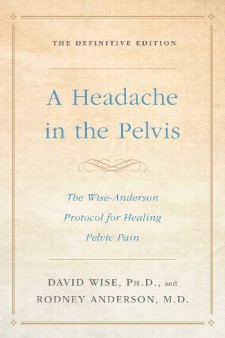Drs. David Wise and Rodney Anderson Address a New Treatment for Prostatitis/CPPS in the New Edition of Their Top-Selling Guide on Treating Chronic Pelvic Pain - 'A Headache in the Pelvis'

SAN FRANCISCO, May 31, 2018 (Newswire.com) - The new, definitive edition of the top-selling chronic pelvic pain guide "A Headache in the Pelvis" (Harmony Books; on-sale now) describes the Wise-Anderson Protocol for chronic pelvic pain syndromes. Despite common misconceptions, one of the largest group of pelvic pain sufferers are men, who have been diagnosed with prostatitis/CPPS. In fact, we have found that most male patients complaining of genital, rectal, lower abdominal/pelvic pain, pain during or after sex and associated urinary urgency and frequency are typically diagnosed with prostatitis/CPPS. Almost all of them do not have a problem with the prostate gland. Considerable medical research confirms this fact. Only one or two of twenty men will be found to have a treatable infection of the gland.
Symptoms diagnosed as prostatitis/CPPS that are not prostate-related cannot be determined by traditional evaluation such as internal inspection, radiologic imaging, or prostatic fluid analysis. A physician dealing with someone complaining of these symptoms must understand this invisible problem and be able to palpate the pelvic floor for trigger points and myofascial restriction appropriately to be able to diagnose it. Conventional medical treatment typically does not help.
After 24 years of experience treating several thousand patients, Drs. Wise and Anderson have documented that most cases of diagnosed prostatitis/CPPS they have seen are actually disorders of the muscles of the pelvis, not disorders of the prostate gland.
This watershed paradigm introduced in the "A Headache in the Pelvis" reflects over 2 decade’s worth of data collected by the doctors. The pelvic floor muscle dysfunction, typically involving an ongoing type of spasm and chronic tension in the pelvic muscles usually result from the prolonged tightening of the muscles of the pelvic floor that creates neuromuscular havoc. A little known, but critical phenomenon.
An abnormally high level of tension in the pelvic muscles, which can be described as chronic pelvic hypertonicity, can be confirmed by the manual palpation of these muscles by an experienced physician or physical therapist. In the vast majority of men, painful myofascial trigger points develop in and around the pelvic muscles and refer pain as the result of this chronic pelvic tension.
Unlike a scrape or irritation that appears in other parts of the body and then heals up easily, men diagnosed with prostatitis/CPPS are usually baffled as to why their symptoms don’t just go away like other temporary aches, pains and irritated tissue in the body. The Wise and Andersons’ seminal insight is that painful trigger points and muscle restriction in the pelvis set in motion a self-feeding cycle of irritated pelvic tissue caused by chronic tensing and reduction of blood flow, anxiety, pain, and reflex protective guarding. Each of these elements feeds the cycle. Once this cycle is in motion, it develops a life of its own and can go on for years if left untreated.
For this reason, Wise and Anderson stress that training patients in self-treatment is key. The therapeutic focus of the Wise-Anderson Protocol is in training patients to physically release pelvic floor related trigger points both internally and externally. Described in "A Headache in the Pelvis," the Wise-Anderson Protocol trains sufferers with the use of their Internal Trigger Point Wand, the only FDA approved device for self-treatment of pelvic floor trigger points to release the pelvic muscles. Recently, patients are treated with their new Trigger Point Genie for external trigger points that makes external trigger point release comfortable, easy and able to be done on soft surfaces.
Going hand in hand with the trigger point release self-treatment, the Wise-Anderson Protocol trains patients to remove the major perpetuation factors of ongoing protective guarding, nervous arousal and anxiety. Essential to this process is training patients in Extended Paradoxical Relaxation, when performed daily, can significantly reduce the high arousal of the nervous system and provide in inner healing environment for the sore pelvic floor associated with prostatitis/chronic pelvic pain syndrome. These methods are all described extensively in "A Headache in the Pelvis."
"A Headache in the Pelvis" describes a solution for patients seeking a long-term answer to this miserable condition. Outside of the box of the conventional thinking and treatment, this landmark book finally turns the light on an issue that for so long has been a dark and misunderstood ailment.
DAVID WISE, Ph.D., worked with Stanford urologist Dr. Rodney Anderson for 8 years in developing the Wise-Anderson Protocol. He is a psychologist in California and his research interests are in behavioral medicine and autonomic self-regulation.
RODNEY U. ANDERSON, M.D., FACS, is a professor of urology (emeritus-active) at Stanford University School of Medicine. His subspecialty clinical expertise is neuro-urology and female urology. He continues to be actively engaged in clinical research on the Wise-Anderson Protocol and other research.
ABOUT THE BOOK
"A Headache in the Pelvis"
"The Wise-Anderson Protocol for Healing Pelvic Pain: The Definitive Edition"
By David Wise, Ph.D., and Rodney Anderson, M.D.
Harmony Books │$21.99 │ ISBN: 9781524762049
Source: Pelvic Pain Help